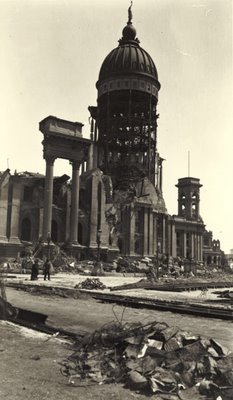
Hey dude, that house is definitely worth a million-five, and I just adore the landfill it’s built on--I loved living in California but one of the reasons I moved had to do with a little adventure on Oct. 17, 1989. I was walking from the restroom down a corridor at my Stanford office when I heard the unmistakable sound of a train running under the building. I knew perfectly well what that meant: there is no train under my office. It was an earthquake. This one seemed dramatically larger than any I had been in before, so I assumed a fetal position on the floor while books, book cases and anything not tied down began to fly around the room. The whole thing lasted 15 seconds (trust me when I tell you it was the longest 15 seconds of my life) and when it was done I was pulling a pregnant co-worker out from under a desk covered by office debris. My son, then a Stanford student, spent the night in a tent until the engineers could determine if the dorm was safe, several old buildings on campus were totally trashed. It was the Loma Prieta Quake
My wife-to-be was on a bridge over a creek in the woods that comprises the UC Santa Cruz campus, also safe, but downtown Santa Cruz was a wreck and people died. If you were watching the Giants-As World Series on television, you saw what happened when a 7.1 quake strikes the Bay Area.
 I bring this up because it is the anniversary today of the Big One, the 1906 earthquake and subsequent fire that destroyed San Francisco (the fire did more damage than the quake, by the way). Also, some scientists are releasing a computer model of what happens if that quake is repeated in the Bay Area. Kind of makes real estate prices look even crazier.
I bring this up because it is the anniversary today of the Big One, the 1906 earthquake and subsequent fire that destroyed San Francisco (the fire did more damage than the quake, by the way). Also, some scientists are releasing a computer model of what happens if that quake is repeated in the Bay Area. Kind of makes real estate prices look even crazier.It could easily match Katrina. The study, reported at a meeting in San Francisco by structural engineer Charles Kircher of Mt. View, using 2,000 census tracts, predicted that as many as 3,400 people could die, 700,000 people would be homeless (when you are homeless from a million dollar cottage you are homeless indeed), the exteriors to 130,000 buildings would be wrecked and damages could be as much as $125 billion. That’s billion with a b. It is absolutely true that modern building codes in California work--think of what a 7.1 quake would do in Afghanistan--but there are still buildings grandfathered out of the code, and even the best code and construction can’t save everyone. The urban core of Oakland, Berkeley and San Francisco still have lots of those buildings and of course that’s where the poor live. You see the picture. The population also is 10 times what it was in 1906 and land values are out of sight. And the same people who handled the hurricane are still in charge. Need I say more?
Most of the people and most of the one-trillion dollars in property are within 25 miles of the San Andreas fault, the geological fault that ripped in '06.
 Our dear friend lived in a beautiful house in the Santa Cruz mountains in 1989, one of the most beautiful houses I’ve ever seen. One minute she was indoors doing something and 15 seconds later she was outdooors. The house collapsed around her. It had not been attached properly to the foundation. It’s likely she’s not the only one that happened to.
Our dear friend lived in a beautiful house in the Santa Cruz mountains in 1989, one of the most beautiful houses I’ve ever seen. One minute she was indoors doing something and 15 seconds later she was outdooors. The house collapsed around her. It had not been attached properly to the foundation. It’s likely she’s not the only one that happened to.The 1906 quake would have registered 7.9 if there was a Richter scale then (remember the scale is logarithmic so the difference between 7.1 and 7.9 is substantial) and it killed 3,000 people and destroyed San Francisco from the bay to Van Ness Street. The federal government got immediately involved and made the situation worse. Some things never change.
Meanwhile, I live in Maryland and now if it is sounds like a train is going under my house--well, it still isn't a train.
[Top photo, city hall, photo by Jack London (yes, that Jack London) courtesy California Parks, middle, dead horses San Francisco 1906 via USGS. Bottom photo Pacific Ave., Santa Cruz 1989 via Santa Cruz Redevelopment Authority].
No comments:
Post a Comment